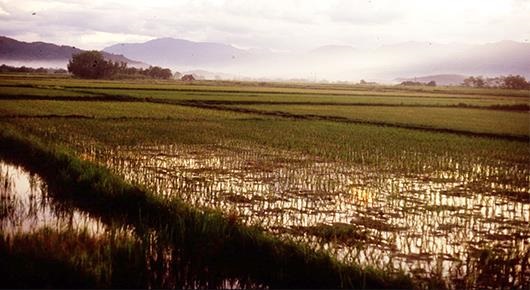
25 August 2017, Can Tho, Viet Nam - Global warming is expected to have a significant impact on future yields of everything from rice to fish, particularly in countries situated closer to the equator, the Food and Agriculture Organization of the United Nations (FAO) warned today.
Geographically, the negative impact of climate change on agricultural output could result in lower yields of rice, wheat, corn and soybeans in countries with tropical climates, compared with the impacts experienced by those in higher latitudes. Fisheries could also be affected by changes to water temperature.
A meeting in Viet Nam of Agriculture Ministers from Asia-Pacific Economic Cooperation (APEC) member economies heard that many key agricultural regions in Asia are already at risk of crossing key climate thresholds after which the productivity of plants and animals goes into decline. For example, research by FAO and other organizations has found that there are regions within Asia that are already near the heat stress limits for rice. Changes in specific climate variables are important too - for example, increased night-time temperatures have been found to have a significant negative impact on rice yields.
Based on the findings of the global research community, the International Panel on Climate Change (IPCC) anticipates that these trends are expected to worsen in the future with the projected impacts of anthropogenic climate change.
A changing environment for trade
"Many APEC economies have already felt the full force of agricultural losses from natural disasters in recent years, with the vast majority of these being climate related. The annual tally runs into the billions and billions of dollars in losses. So the time to act is now. Policy makers need to prepare for changes in supply, shifting trade patterns and a need for greater investment in agriculture, fisheries, land and water management, that will benefit smallholder farmers and others that produce our food," said Kundhavi Kadiresan, Assistant Director-General and FAO Regional Representative for Asia and the Pacific.
"It is imperative that we start thinking now about the hard decisions and actions that the APEC economies, and others, will need to take. Governments will need to consider greater social protection measures. Industry and trade will need to adapt to shifting supply and demand. There is no quick fix but there is every reason to act," Kadiresan added.
There is much that can be done to increase the efficiency of agriculture and land-use activities in Asia, Kadiresan pointed out. The agriculture sectors account for at least one-fifth of total emissions, mainly from the conversion of forests to farmland as well as from livestock and paddy production and application of synthetic fertilizers. It has been estimated that as much as 70 percent of the technical potential to reduce emissions from the agriculture sectors occurs in tropical developing countries that characterize much of Asia.
Action is underway
In Viet Nam, FAO has been working with the Ministry of Agriculture and Rural Development to assess the emissions reduction potential of the System of Rice Intensification and improved livestock management as contributions to Nationally Appropriate Mitigation Actions and Viet Nam's priorities for agriculture.
In Cambodia, Papua New Guinea and Mongolia, FAO, in partnership with the Global Environment Facility (GEF), has recently started developing programmes under the Capacity Building Initiative for Transparency to strengthen national level capacity to measure, monitor and report emissions and adaptation actions in the agriculture and land-use sectors. These programmes will draw upon a range of geospatial and measurement tools FAO has developed through its global programme on Mitigating the Impacts of Climate Change in Agriculture.
In the forestry sector, avoiding deforestation, increasing the area under forest, and adopting sustainable forest management will create invaluable carbon sinks. FAO has been supporting national programmes for reduced emissions from deforestation and forest degradation (REDD+).
The APEC Ministers heard that more resources would be needed in two areas of financing. First, more upfront support for increasing farmers' productivity, building capacity to adapt to climate change and reducing the emissions related to production through, for example, agricultural research. For this to be successful, a second area requires financing - building capacity through appropriate institutions and policies. Climate funds could become an important catalyst for climate change adaptation and mitigation if they are used to build the enabling environment essential for climate-smart agricultural development, while ensuring that public agricultural investment is also climate-smart, and to leverage private finance.
APEC, as an organization of Pacific Rim economies, is well placed to take on a leading role, with strong and wide ranging political commitment, given that its membership includes several of the world's largest and wealthiest economies, as well as some of the smallest and poorest. Many are home to some of the finest research institutes with some of the brightest minds. APEC could, thus, set an example for the rest of the world.